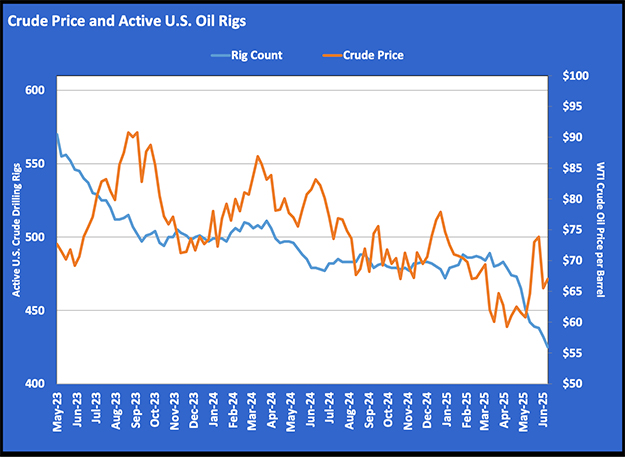Will propane prices stay high this summer?
Trader’s Corner, a weekly partnership with Cost Management Solutions, analyzes propane supply and pricing trends. This week, Mark Rachal, director of research and publications, examines how propane prices could change this summer depending on the geopolitical events currently happening.
During the summer months, propane retailers are generally looking for opportunities to lock in winter prices that can provide better margins and/or price protection for their customers. Given the geopolitical events that are currently in play, it is going to be very tough for anyone to predict where prices will be this summer.
There are four potential scenarios that might drive propane prices lower:
- Crude prices fall.
- Propane demand decreases.
- Propane supply increases faster than domestic and export demand.
- Some combination of two or three of the above.
What could drive crude prices lower?
- The end of the Ukraine war and Europe continues buying Russian energy.
- The market becomes convinced the West will never effectively embargo Russian energy.
- The West stops taking Russian energy, but it still moves to China and India, thus not really limiting global supply.
- The U.S. and Iran finally revive the 2015 nuclear deal, allowing more Iranian crude onto the market.
- The Middle East becomes less interested in appeasing Russia and China and more interested in taking care of consumers in the West.
- Western nations become very aggressive in producing more hydrocarbons.
- A global recession.
What could cause propane demand to decrease other than high prices?
- A global recession.
In this Trader’s Corner, we want to focus on the third scenario – propane supply increases faster than domestic and export demand – since it is the one that we can visualize occurring. It’s not that the conditions above can’t occur, and in fact, we might say that some are probable. Rather, the situation where propane supply could outpace both domestic demand and the U.S.’ ability to export it may already be in play.
How would that occur? Prior to the pandemic, U.S. energy prices were low. The reason was that the U.S. was steadily growing its crude production. Just before the pandemic hit, a record 13.1 million barrels per day (bpd) was produced. Natural gas and propane are produced along with the crude, called associated production, increasing the supply of both. The supply of natural gas and propane was outpacing domestic demand prior to the pandemic. Since the export capacity of both is limited, the result was to take the upward price pressure off propane and natural gas.
U.S. crude production went up last week to 11.8 million bpd, still 1.3 million bpd below its peak. The U.S. is a net importer of crude. In January, the U.S. imported 6,530,000 bpd of crude and exported 2,536,000, making it a net importer of 3,994,000 bpd. At least 60 percent of U.S. crude imports are heavy crude, which we will have to continue since most of our crude production is light crude and our refineries need heavy crude as well. Theoretically, that means the U.S. has the opportunity to increase its production by around 2.6 million bpd to offset the light crude it is importing. That would allow that 2.6 million bpd of crude to go to Europe instead.
Frankly, we are not sure we can offset all of the light crude we are getting; however, we already know crude production could be increased to the 13.1-million-bpd level seen before the pandemic. We expect there is room for more production. Even if crude production is just brought back to the pre-pandemic level, the associated natural gas and propane that would supply would likely exceed the domestic demand and the U.S. export capacity of both.
Both U.S. natural gas and propane exports are near their operable capacity already. To keep the increased crude production from driving down natural gas and propane prices, more natural gas and propane export capacity needs to be added. Industry sources tell us there is no new propane export capacity under construction presently. The minimum time to add export capacity to existing propane export facilities is 18 months.
There are a couple of new natural gas export facilities under construction that will be completed this year that will add about 10 percent to capacity. After those are completed, the next projects aren’t due to be operational for several years. Even if those jobs are expedited, there will be export constraints in the short term.
In a nutshell, a viable scenario is that U.S. crude production could rise faster than new export capacity could be constructed that could handle the associated propane and natural gas production that would result. Should that occur, it could put downward pressure on the price of propane and natural gas.
A key focus for this summer is to monitor U.S. crude production to see if it is indeed increasing. If it is, will there be any news of new propane export capacity starting construction? If there is not, one cannot discount the potential for downward pressure on propane prices developing. We do believe confidently that the global demand for U.S.-sourced LNG and propane will be strong in the short term. The question is if there will be enough export capacity to meet the demand?
Call Cost Management Solutions today for more information about how client services can enhance your business at 888-441-3338 or drop us an email at info@propanecost.com.
Featured homepage image: tttuna/E+/Getty Images
















